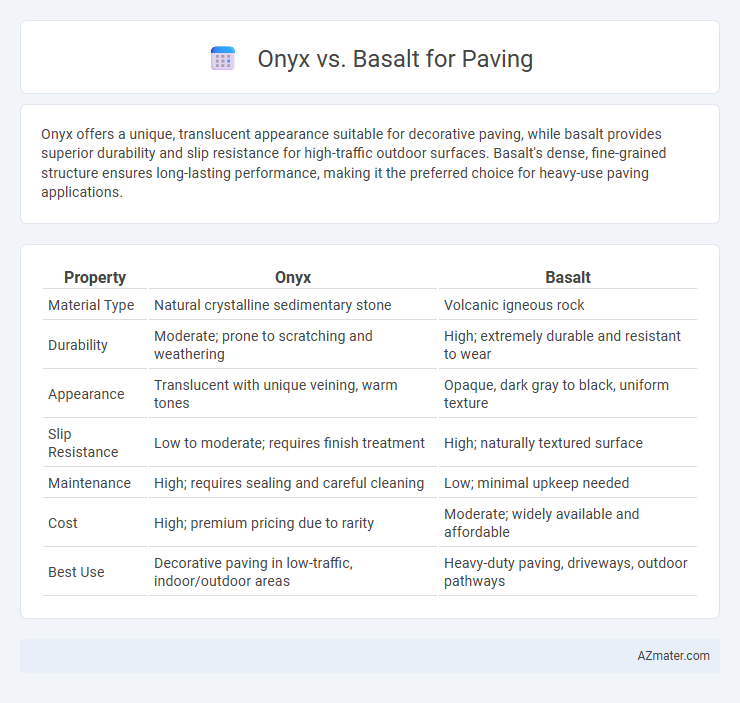Onyx offers a unique, translucent appearance suitable for decorative paving, while basalt provides superior durability and slip resistance for high-traffic outdoor surfaces. Basalt's dense, fine-grained structure ensures long-lasting performance, making it the preferred choice for heavy-use paving applications.
Table of Comparison
| Property | Onyx | Basalt |
|---|---|---|
| Material Type | Natural crystalline sedimentary stone | Volcanic igneous rock |
| Durability | Moderate; prone to scratching and weathering | High; extremely durable and resistant to wear |
| Appearance | Translucent with unique veining, warm tones | Opaque, dark gray to black, uniform texture |
| Slip Resistance | Low to moderate; requires finish treatment | High; naturally textured surface |
| Maintenance | High; requires sealing and careful cleaning | Low; minimal upkeep needed |
| Cost | High; premium pricing due to rarity | Moderate; widely available and affordable |
| Best Use | Decorative paving in low-traffic, indoor/outdoor areas | Heavy-duty paving, driveways, outdoor pathways |
Introduction to Onyx and Basalt Paving
Onyx and basalt are both popular choices for paving due to their durability and aesthetic appeal, but they possess distinct characteristics that influence their usage. Onyx is a translucent, calcite-based stone prized for its unique veining and vibrant color variations, making it ideal for decorative applications where visual impact is prioritized. Basalt, a dense volcanic rock with a fine-grained texture and rich dark tones, offers superior hardness and slip resistance, making it a preferred material for high-traffic outdoor paving projects.
Geological Differences: Onyx vs Basalt
Onyx is a form of calcite, characterized by its banded, translucent appearance and composed primarily of calcium carbonate, making it softer and less durable than basalt. Basalt is an igneous volcanic rock, composed mainly of pyroxene and plagioclase minerals, known for its high density, hardness, and resistance to weathering, ideal for heavy-duty paving applications. The geological composition of onyx leads to unique aesthetic patterns but lower structural strength, whereas basalt offers superior durability and longevity in outdoor paving projects.
Aesthetic Appeal and Color Variations
Onyx offers a unique translucent quality with rich color variations ranging from deep blacks to warm ambers, enhancing the aesthetic appeal of paving by adding depth and a luxurious finish. Basalt features a more uniform, matte texture with natural dark gray and black tones, providing a sleek, modern appearance that complements minimalist designs. Both materials showcase durability, but Onyx stands out for striking color patterns, while Basalt excels in consistent dark hues ideal for contemporary paving projects.
Durability and Strength Comparison
Onyx offers moderate durability but is more prone to scratching and weathering compared to basalt, which is a volcanic rock known for its exceptional hardness and resistance to wear. Basalt's high compressive strength and low porosity make it an ideal choice for heavy-traffic paving applications where long-term performance and minimal maintenance are critical. Compared to onyx, basalt provides superior strength and durability, making it a preferred material for commercial and industrial paving projects.
Slip Resistance and Surface Texture
Onyx offers a smooth, polished surface that enhances aesthetic appeal but may reduce slip resistance, making it less ideal for wet or high-traffic paving areas. Basalt features a naturally rough, textured surface providing superior slip resistance and durability, crucial for safety in outdoor environments. Selecting basalt for paving ensures enhanced traction and minimizes slip hazards, especially in rainy or icy conditions.
Weather and Temperature Performance
Onyx and Basalt differ significantly in weather and temperature performance for paving applications. Onyx, with its smooth texture and luxurious appearance, is less resistant to extreme temperature fluctuations and may suffer surface deterioration in freeze-thaw cycles. Basalt offers superior durability and thermal stability, making it ideal for harsh climates with variable weather, as it retains structural integrity and slip resistance under temperature extremes.
Maintenance Requirements and Longevity
Onyx paving stones require minimal maintenance due to their natural resistance to stains and scratches, making them ideal for high-traffic outdoor areas. Basalt, known for its exceptional durability and weather resistance, offers enhanced longevity but may need periodic sealing to prevent moisture absorption and surface erosion. Choosing between Onyx and Basalt depends on balancing the ease of upkeep with desired lifespan and environmental exposure.
Cost Considerations and Value
Onyx paving offers a luxurious, high-end appearance but comes at a significantly higher cost compared to basalt, which provides a more affordable yet durable option suitable for large-scale projects. Basalt's longevity and low maintenance requirements deliver exceptional value over time, making it a cost-effective choice for both residential and commercial paving. While onyx adds aesthetic appeal, basalt's balance of durability and price ensures maximum return on investment for practical applications.
Environmental Impact and Sustainability
Onyx and basalt differ significantly in their environmental impact and sustainability for paving applications. Basalt is a natural volcanic rock known for its durability and low carbon footprint due to minimal processing requirements, making it an eco-friendly choice. Onyx, often requiring intensive quarrying and energy-consuming refinement, generally has a higher environmental cost, reducing its overall sustainability in paving projects.
Best Applications: Choosing Onyx or Basalt for Your Project
Onyx offers a luxurious, unique aesthetic with its translucent and varied patterns, making it ideal for decorative paving in high-end residential or commercial spaces where visual impact is prioritized. Basalt provides exceptional durability, slip resistance, and thermal stability, making it perfect for heavy-traffic areas, outdoor walkways, and industrial paving requiring long-lasting strength. Selecting between Onyx and Basalt depends on whether the project emphasizes artistic elegance or functional performance.

Infographic: Onyx vs Basalt for Paving
 azmater.com
azmater.com